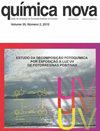MICROPLASTICS AND THE AMAZON: FROM THE RIVERS TO THE ESTUARY
IF 0.5
4区 化学
Q4 CHEMISTRY, MULTIDISCIPLINARY
引用次数: 0
Abstract
Plastic pollution is causing worldwide concern, especially after evidence that the various types of plastic degrade into particles of smaller sizes; known as micro- and nanoplastics. The origin of the plastics in the environment is related to human actions. The objective of this review is to describe the main routes of microplastic input in the Amazonian rivers and how local environmental characteristics can affect the transformation of plastics into microplastics until their absorption by aquatic organisms. The current situation regarding the presence of microplastic particles in freshwater is analyzed considering the environmental dynamics of the region, and focuses on rivers, estuaries and sediments, their effects on organisms, especially on fish, followed by the transportation of microplastic particles to the sea. Amapá, Amazonas, Pará and Mato-Grosso are the states of the Brazilian Amazon with scientific reports on the characterization of microplastic particles in sediment, water, and fish. These studies are local and descriptive and most of them highlight the characterization of microplastics. There is a need for field research in the various microregions of the Amazon, as well as actions to mitigate the damage, including to riverine populations, that is caused by these pollutants in the region.微塑料和亚马逊河:从河流到河口
塑料污染正在引起全世界的关注,特别是有证据表明,各种类型的塑料可降解成更小的颗粒;被称为微塑料和纳米塑料。环境中塑料的来源与人类活动有关。本综述的目的是描述微塑料进入亚马逊河流的主要途径,以及当地环境特征如何影响塑料向微塑料的转化,直到它们被水生生物吸收。考虑到该地区的环境动态,分析了淡水中微塑料颗粒存在的现状,重点关注河流,河口和沉积物,它们对生物,特别是对鱼类的影响,然后是微塑料颗粒向海洋的运输。亚马孙州、亚马孙州、帕尔州和马托格罗索州是巴西亚马逊河流域的几个州,有关于沉积物、水和鱼类中微塑料颗粒特征的科学报告。这些研究都是地方性的、描述性的,其中大多数都强调了微塑料的特征。有必要在亚马逊河的各个微区域进行实地研究,并采取行动减轻这些污染物在该区域造成的损害,包括对河流人口造成的损害。
本文章由计算机程序翻译,如有差异,请以英文原文为准。
求助全文
约1分钟内获得全文
求助全文
来源期刊

Quimica Nova
化学-化学综合
CiteScore
1.60
自引率
12.50%
发文量
72
审稿时长
2-4 weeks
期刊介绍:
Química Nova publishes in portuguese, spanish and english, original research articles, revisions, technical notes and articles about education in chemistry. All the manuscripts submitted to QN are evaluated by, at least, two reviewers (from Brazil and abroad) of recognized expertise in the field of chemistry involved in the manuscript. The Editorial Council can be eventually asked to review manuscripts. Editors are responsible for the final edition of QN.
 求助内容:
求助内容: 应助结果提醒方式:
应助结果提醒方式:


